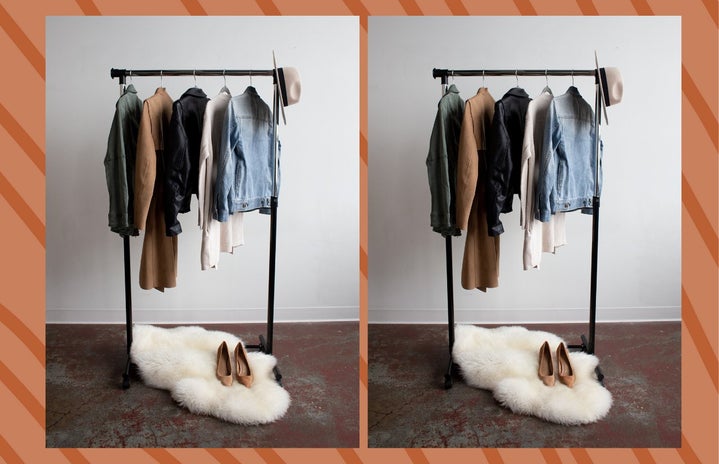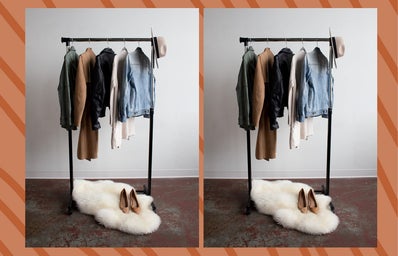When you’re into fashion, you don’t need a reason to dress up. You just dress up, even if you’re going to the post office. Moreover, when you’re addicted to shopping, you don’t need a reason to shop. You’ll buy pieces just because you can. Like, because it’s shiny and you don’t own anything shiny. Because your wardrobe will finally be complete. That you could always use a pair of red snow boots.
No, seriously. For a long time, I was unwilling to admit that I had a serious fashion addiction. Even when my bank account dipped into the negatives, I refused to believe that it was a problem. “I’m a broke college student,” I told people while sporting a Christian Dior scarf.
Now, only my own hard-earned money has supported my shopping habits, which makes me feel a little better, honestly. And, of course, I try to be sustainable when I shop. I thrift often and I try not to purchase from fast fashion brands. I like to know where my pieces are coming from, if the workers were treated fairly, or if the company has ethical practices. But these facts do not change anything when it comes to my addiction.
During my senior year of high school, I sold most of my clothing and accessories online. A humbler me would say that I purged my wardrobe to earn extra money for college. But the true reason was that I wanted to rebrand myself. I knew I was headed for Manhattan and I wanted to look the part. I was seeking a career in writing and television. How would anyone take me seriously in funky knits from Urban Outfitters?
My pieces sold quickly and feverishly. Little by little, I watched the freshman, sophomore, and junior versions of myself get stuffed into USPS packages and shipped to other parts of the USA. It was as liberating as it was humiliating. Senior year, I showed up to school in faded corduroys and grandma-chic cardigans. I wasn’t totally against the look – it went with my cute bob haircut, at the time. But it wasn’t really my best look, and my family let me know it. “What happened to you?” my Brooklynite father said to me one evening. “You used to dress like the It-Girl. Now you dress like a bag-lady.”
The comments didn’t matter to me, though. Five more months and I’m out of here, I thought to myself. I slid into baggy overalls and shipped riding boots off to North Dakota. I laughed into turtlenecks as I watched my checking account skyrocket.
With an empty closet staring back at me, there was room to hang up new fantasies I had for myself. I curated lists of pieces I needed and dreams attached to those pieces. I need a black blazer to wear to meetings. What kind of meetings? I had no idea, but I figured there would be internships. Then, I moved on to white shirts because every brunette needs a crisp white shirt. The desires began to lack any sensibility. I need an emerald-green-velvet-dress to wear as I ice-skate in Rockefeller Center. This faux-fur sweater would look so stylish if I ever go to Munich and pair it with vintage Levis.
I arrived in New York with virtually no clothes – only a handful of black and white pieces and my pajamas. By the time it was Thanksgiving, however, I was rocking a Fendi Roma and a questionable credit balance. I knew that I had a problem but I couldn’t help myself. Styling an outfit feels as amazing as writing poetry. Thrifting designer bags — in good condition — is better than sex. How could I stop buying clothes when the outcome brought my immense pleasure?
There is also something to be said about dressing loudly as a writer. We are, somewhat, a group of unseen artists. Our work is hidden, tucked away into the spines of books within the dust of libraries. Our poems may come across like secrets, and our memoirs, though personal, are typically not sought after unless you know the name. And even those writers’ faces are not well-known by their fans. (Do you know what F. Scott Fitzgerald’s face looks like? Sandra Cisneros? Langston Hughes?)
So dressing loudly, as a writer, finally felt like a way to be “seen”. Fashion made me feel like I was a part of a metaphysical space — a space that captured my sophisticated voice and elegant handwriting. I could dress like a poem. I could kiss like one, even.
Yet my identities as a writer, as a hopeless romantic, and as a new New Yorker were my very flaws, too. I had the terrifically-awful skill of giving pieces their own stories: the first kiss skirt, the “just published” wool coat, the picnic-in-the-park dress. I could convince myself to buy any piece because every piece had a story that could come true in my life. The danger of that potential is that it is limitless; my wardrobe is never finished because a story is never truly finished.
But here’s a story. Earlier this year, I left a relationship that made me doubt my worth. We had gotten into an argument one night – the kind of argument that preludes a breakup – so he rummaged through my closet and packed away some of my clothes. I was ready to leave, so I did — and I took his assortment with me.
It wasn’t until I was on the couch of my friend’s apartment, bleary-eyed and snotty, that I realized he never knew me. I opened the bag of clothes that he packed for me; sparkly tulles, gingham pinafore, and satin slips. I walked around like a goddamn picnic fairy for a week.
Had he, too, created a story of me in this wardrobe? Perhaps he thought that I should come back to him shimmery and soft. Or perhaps this wardrobe was his projection of the woman he really wanted me to look like. I reached the end of the bag-pile one day and was surprised to pull out the emerald-green-velvet-dress — the one I had destined for Rockefeller Center ice skating. It was still new with tags, unworn and untold.
I looked at the garment and thought: the breakup dress? And then it dawned on me; our clothes aren’t stagnant. There are several sides to every story, and our narratives are always changing. The dress could be both for Munich and Rockefeller and a breakup. I didn’t need to buy new pieces. My ex had created an entirely new aesthetic, out of my own wardrobe, in about ten minutes.
Since getting the rest of my clothing back, I have taken a step back and began to sort it out: piles to sell, piles to donate, piles to keep. I am not looking to restock my shelves the way I once did, but I would be lying if I said I’m entirely done with fashion. I’m not.
What I am done with, though, is writing wild narratives. As I approach graduation and, therefore, uncertainties – I am trying, more than ever, to stay in the now. Here’s a wool beret that says I don’t know why I have to take this business class. Here’s a plaid skirt that says I’m so happy in my current relationship. I can look like anyone or any poem. Just give me ten minutes.


